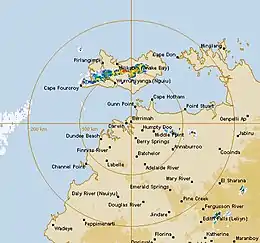Hector (cloud)
Hector is a cumulonimbus thundercloud that forms regularly nearly every afternoon on the Tiwi Islands in the Northern Territory of Australia, from approximately September to March each year.[1][2][3] Hector, or sometimes "Hector the Convector", is known as one of the world's most consistently large thunderstorms, reaching heights of approximately 20 kilometres (66,000 ft).[4]

History


Named by pilots during the Second World War, the recurring position of the thunderstorm made it a navigational beacon for pilots and mariners in the region. Hector is caused primarily by a collision of several sea breeze boundaries across the Tiwi Islands and is known for its consistency and intensity.[5] Lightning rates and updraft speeds are notable aspects of this thunderstorm and during the 1990s National Geographic magazine published a comprehensive study of the storm with pictures of damaged trees and details of updraft speeds and references to tornadic events.
Since the late-1980s the thunderstorm has been the subject of many meteorological studies, many centred on Hector itself,[4][6][7][8] but also utilising the consistency of the storm cell to study other aspects of thunderstorms and lightning.
References
- The cloud called Hector. The Cloud Appreciation Society. Retrieved on 2010-11-30.
- P. T. May; et al. (2009). "Aerosol and thermodynamic effects on tropical cloud systems during TWPICE and ACTIVE" (PDF). Atmos. Chem. Phys. 9: 15–24. doi:10.5194/acp-9-15-2009.
- Beringer, Jason; Tapper, Nigel J.; Keenan, Tom D. (2001). "Evolution of maritime continent thunderstorms under varying meteorological conditions over the Tiwi Islands" (PDF). International Journal of Climatology. 21 (8): 1021. Bibcode:2001IJCli..21.1021B. doi:10.1002/joc.622. Archived from the original (PDF) on 1 March 2011. Retrieved 25 November 2010.
- Crook, N. Andrew (1 June 2001). "Understanding Hector: The Dynamics of Island Thunderstorms". Monthly Weather Review. 129 (6): 1550–1563. Bibcode:2001MWRv..129.1550C. doi:10.1175/1520-0493(2001)129<1550:UHTDOI>2.0.CO;2.
- Beringer, Jason; Tapper, Nigel J.; Keenan, Tom D. (30 June 2001). "Evolution of maritime continent thunderstorms under varying meteorological conditions over the Tiwi Islands". International Journal of Climatology. 21 (8): 1021–1036. Bibcode:2001IJCli..21.1021B. doi:10.1002/joc.622.
- Barker, Anne (14 November 2005). "Researchers to investigate impact of storms". The World Today. Australian Broadcasting Corporation. Retrieved 11 July 2011.
- Casben, Liv (14 February 2006). "Scientists complete storm study". PM. Australian Broadcasting Corporation. Retrieved 11 July 2011.
- "Our changing atmosphere". Planet Earth Online. Natural Environment Research Council. 23 April 2007. Archived from the original on 6 October 2011. Retrieved 11 July 2011.